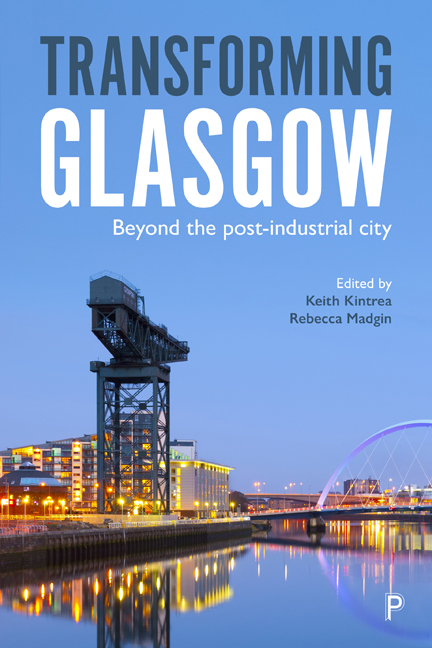Book contents
- Frontmatter
- Contents
- List of Maps, Tables, Figures and Boxes
- Notes on Contributors
- Acknowledgements
- Foreword
- Map
- Introduction: Transforming Post-Industrial Glasgow – Moving Beyond the Epic and the Toxic
- PART I
- PART II
- PART III
- Conclusion: Beyond the Post-Industrial – Narratives of Time and Place
- Index
4 - Stopped in its Tracks? Transport’s Contribution to Glasgow’s Development
Published online by Cambridge University Press: 25 March 2021
- Frontmatter
- Contents
- List of Maps, Tables, Figures and Boxes
- Notes on Contributors
- Acknowledgements
- Foreword
- Map
- Introduction: Transforming Post-Industrial Glasgow – Moving Beyond the Epic and the Toxic
- PART I
- PART II
- PART III
- Conclusion: Beyond the Post-Industrial – Narratives of Time and Place
- Index
Summary
Introduction
Glasgow is a city of transport innovation. It is home to the third oldest underground railway in the world, opened in 1896. It has by far the most extensive urban motorway network in the UK, the product of a tradition of strong regional planning that dates back almost a century. It pioneered the pedestrianisation of key city centre streets from the 1970s, such that the city's showpiece thoroughfare, Buchanan Street, has won international awards for the quality of its public realm.
But Glasgow is also a place in which these innovations are not always seen through to maturity, and so the city's transport network today is in part excellent, mostly adequate, but too often poor. The reasons for this are complex, but reflect the wider economic fortunes of the city itself through time, but also the successive changes in governance of both the transport sector and local administration across the city region since the 1920s, and in particular the difficulties of making multi-level governance actually work (see Marsden et al, 2014; Gray, Docherty and Laing, 2017). Glasgow's transport story is therefore one – sometimes literally – of planned transformations being stopped in their tracks. This lack of policy coherence means that getting around Glasgow today can be a frustrating experience at times given the level of fragmentation evident in its physical networks and in the lack of coordination of the services that run on it. The city's wide incomeand spatial inequalities are also apparent in the transport sector: whilst most of the wealthy suburbs and commuter towns have high levels of car ownership and good quality rail connections supported by substantial government subsidies, many lower income communities, especially those in inner urban areas, rely heavily on commercial buses, a sector which seems in possibly terminal decline, and without which people who can barely afford it are forced to run a car (Curl, Clark and Kearns, 2018). Thus the varying pattern of accessibility across the city offered by its transport networks helps explain and reproduce many of the city's longstanding socio-economic challenges.
Although the Glasgow of today has a (very) good transport network overall by UK standards, if the city is to confirm and sustain its place amongst its European and global peer group, there is much still to do.
- Type
- Chapter
- Information
- Transforming GlasgowBeyond the Post-Industrial City, pp. 81 - 98Publisher: Bristol University PressPrint publication year: 2019



